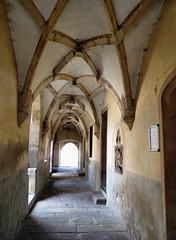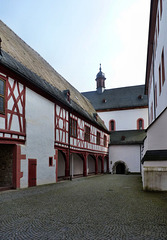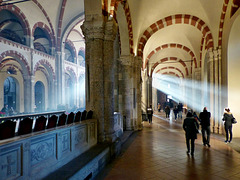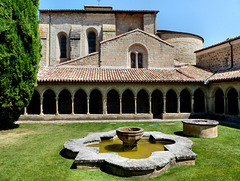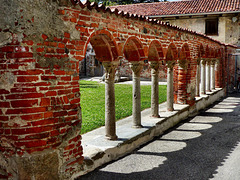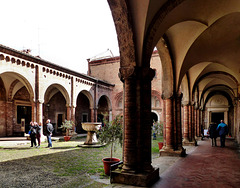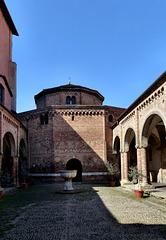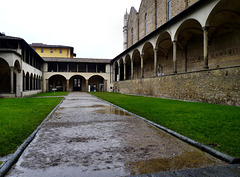
Cloister / Cloître / Kreuzgang
A cloister (from Latin "claustrum") is a covered walk, open gallery running along the walls of buildings and forming a quadrangle. The attachment of a cloister to a cathedral or church indicates that it is (or was) part of a monastic foundation.
Cologne - MAKK
| |
|
|
Cologne is the fourth-largest city in Germany - and one of the oldest. A Germanic tribe, the Ubii, had a settlement here, this was named by the Romans "Oppidum Ubiorum". In 50 AD, the Romans founded "Colonia Claudia Ara Agrippinensium", the city then became the provincial capital of "Germania Inferior".
The MAKK (Museum fuer Angewandte Kunst / Museum of Applied Arts Cologne) not only has a collection of outstanding design-pieces, it also has this cosy coffee shop in the center of Cologne. Here you can sip a cappucino and admire the Gothic tracery of the former cloister.
Tomar - Convento de Cristo
| |
|
|
Tomar today is a modern city with a population of about 40.000.
After the conquest of the area from the Moors by Portugal´s first king Afonso Henriques in 1147, the land was granted in 1159 as a fief to the Order of the Knights Templar, who erected the castle/monastery "Convento de Cristo" here, that later became the headquarters of the Order in Portugal.
Gualdim Pais, Grand Master of the Order, granted priviliges to the evolving town already in 1162. After the Order of the Knights Templar was suppressed in 1314 King Dinis was able to transfer the possessions and personnel of the Order in Portugal to a newly created Order of Christ. In the 15th century Henry the Navigator was made the Governor of the Order. He was the central figure in the early days of the European maritime discoveries and maritime expansion, later known as the "Age of Discovery", and he may have used resources and knowledge of the Order to succeed in his enterprises in Africa and in the Atlantic.
In 1492 the Jews were expelled from Spain. Many refugees settled in Tomar, what helped the town to develop. Jews lived here undisturbed for several decades until the Portuguese Inquisition got installed. Many could escape by migrating, but about 1000 were tortured and executed.
Tomar was occupied by the French during the Napoleonic invasions and was liberated by Portuguese and English troops commanded by the Duke of Wellington.
When Henry the Navigator was the Governor of the Order, much money was invested into the rebuilding of the "Convento de Cristo" in flamboyant Gothic / Manueline renaissance style. The "Convento de Cristo", that towers over Tomar, has a couple of different cloisters.
Tomar - Convento de Cristo
| |
|
Tomar today is a modern city with a population of about 40.000.
After the conquest of the area from the Moors by Portugal´s first king Afonso Henriques in 1147, the land was granted in 1159 as a fief to the Order of the Knights Templar, who erected the castle/monastery "Convento de Cristo" here, that later became the headquarters of the Order in Portugal.
Gualdim Pais, Grand Master of the Order, granted priviliges to the evolving town already in 1162. After the Order of the Knights Templar was suppressed in 1314 King Dinis was able to transfer the possessions and personnel of the Order in Portugal to a newly created Order of Christ. In the 15th century Henry the Navigator was made the Governor of the Order. He was the central figure in the early days of the European maritime discoveries and maritime expansion, later known as the "Age of Discovery", and he may have used resources and knowledge of the Order to succeed in his enterprises in Africa and in the Atlantic.
In 1492 the Jews were expelled from Spain. Many refugees settled in Tomar, what helped the town to develop. Jews lived here undisturbed for several decades until the Portuguese Inquisition got installed. Many could escape by migrating, but about 1000 were tortured and executed.
Tomar was occupied by the French during the Napoleonic invasions and was liberated by Portuguese and English troops commanded by the Duke of Wellington.
When Henry the Navigator was the Governor of the Order, much money was invested into the rebuilding of the "Convento de Cristo" in flamboyant Gothic / Manueline renaissance style. The "Convento de Cristo", that towers over Tomar, has a couple of different cloisters.
Osnabrueck - Cathedral St. Peter
| |
|
The bishop´s see was founded by Charlemagne around 780. The first church here, was destroyed by the Normans about 100 years later. After a great fire, that burnt down most of the town around 1100, the cathedral was built over a long period, so it is a mix of late- romanesque and gothic style.
The old cloister, next to the cathedral St. Peter, houses the graveyard today.
Lautenbach - Collégiale Saint Gangolph
| |
|
Theologian Manegold of Lautenbach, a celebrity of his time, lived here in the 11th. century. During the Investiture Controversy, Manegold sided strongly with Pope Gregory VII. Emperor
Henry IV was so annoyed about this, that he sent an army, to destroy the monastery and churches. That ended the monastery 1084. About 50 years later Augustinian Canons settled here - and rebuilt the church, reusing a lot of old material.
I had been here before. So now I just add a few shots, that I did not had taken before .
The last remaining part of the former cloister has a gothic vaulting. As the adjoining building is now used by the local government, the door to the right opens to the office of the mayor. Office hours can be found on the little framed plaque on the wall.
More photos of the Collégiale Saint Gangolph are in the set
www.flickr.com/photos/martin-m-miles/sets/72157626442170032/
Kloster Eberbach / Eberbach Abbey
| |
|
Kloster Eberbach was founded in 1136 by Bernard of Clairvaux as the first Cistercian monastery on the east bank of the Rhine. A small Benedictian monastery had been here before, but after the Cistercian "relaunch", the abbey really thrived, becoming one of the largest and economically most sucessful in Germany. During the 12th/13th century about 100 monks plus 200 lay brothers lived here. Already in 1211, Kloster Eberbach possessed more than 200 settlements, all quoted in the "Oculus Memoriae", an "inventory list".
Despite some setbacks due to wars, the monastery continued very sucessfully upto the time of the French Revolution, when the decline started. Politics changed dramatically during the time of secularisation. In 1803 the abbey was dissolved, the remaining monks were forced to leave. The complex with all assets came into the ownership of the last Prince of Nassau-Usingen. From 1866 on, it was owned by Prussia, later Hesse. The buildings were used as a prison and as a lunatic asylum during that time.
Meanwhile the management of the vast vineyards (~ 200 hectares) and wine production has continued in state hands. Great white wines are produced here! The buildings now are owned by a charitable foundation, aiming to maintain the important complex.
The buildings, in which the lay-brothers lived and worked were separated by this yard from the monks´ enclosure, built all around the cloister. They had as well a different entrance to the abbey church, seen in the back.
kloster-eberbach.de/
Milan - Basilica of Sant'Ambrogio
| |
|
|
|
Milan is the city capital of the Lombardy and the second most populous city in Italy after Rome. Known during Roman times as "Mediolanum" it was the place, where in 313 Constantine I and Licinius met and "signed" the "Edict of Milan", giving Christianity a legal status within the Roman empire.
At the end of the Roman empire Milan was besieged by the Visigoths in 402, looted by the Huns in 452, and taken by the Ostrogoths in 539. Only 30 years later is belonged to the Kingdom of the Lombards, until in 774 Charlemagne defeated the Langobards and added Milan to the Carolingian empire. During Barbarossa´s (Frederik I) "Italian Campaigns" Milan was taken and destroyed to a great extent.
The "Basilica of Sant'Ambrogio" is much older and was not destroyed by Barbarossa´s troops. It is one of the most ancient churches in Milan, built by St. Ambrose in 379–386, outside the city of Milan on the site of a cemetery, where the martyrs of the Roman persecutions had been buried. The first name of the church was "Basilica Martyrum".
Ambrose, born into a noble family about 340 in (present-day) Trier (Germany), was governor of Liguria and Emilia for two years before he became the Bishop of Milan in 374 by popular acclamation. He was a staunch opponent of Arianism.
Only very few traces of the first church can still be found, as in the centuries after its construction, the basilica underwent numerous restorations and reconstructions. The current Romanesque church, mostly built in brickwork, was begun around 1080.
In 789, a Benedictine monastery was established here. The canons of the basilica, however, retained their own community. So two separate communities shared the basilica. In the 11th century, the canons adopted orders and became Canons Regular. From then on two separate monastic orders following different rules lived in the basilica. The canons were in the northern building, the cloister of the canons, while the monks were in the two southern buildings.
The two towers symbolize the division in the basilica. The 9th century Torre dei Monaci ("Tower of the Monks") tower was used by the monks. However, the canons did not have a bell tower and were not allowed to ring bells until they finished the Canons' bell tower in the 12th Century. This tower got two additional levels in 1889.
In 1943 the basilica got severely damaged by bombings. It took a decade to rebuilt and reconstruct the church.
Light floods through the Basilica of Sant'Ambrogio in the later afternoon.
Hirsau - Abbey
| |
|
Twenty years after Pope Leo IX had asked his nephew Count Adalbert of Calw to rebuild the ruined abbay St. Aurelius, this abbey got a young abbot. Wilhem von Hirsau (aka "William of Hirsau"), educated at St. Emmeram in Regensburg, a very well known "thinktank". Immidietly tried to gain independence of all secular powers for the abbey. At that time, he was probably influenced by the idea, that had spread from Gorze Abbey in Lorraine. He was a strong supporter of the Pope during the Investiture Controversy. Already in 1082 he commissioned the building of a new monastery on a nearby high plateau. In 1091 the abbey church, modelled on Cluny II and dedicated to Peter an Paul, got consecrated.
The convent followed 1092 and moved into a monastic compound designed according to the Plan of Saint Gall. Wilhelm´s friend Ulrich (aka "Ulrich von Zell", "Ulrich von Cluny"), a schoolmate from St. Emmeram, had made carreer in Burgundy and was an advisor to Abbot Hugh of Cluny. So the Cluniac reform found their way into the Black Forest. Based on them Wilhelm wrote down the "Consuetudines Hirsauginenses". Known as the "Hirsau Reforms", the adoption of these rules revitalised Benedictine life throughout Germany - and were followed by far more than 100 monasteries.
Based on a thriving economy most of the romanesque buildings (but not the church!) were demolished and got replaced by gothic style structures. Shortly after that, the Reformation put an end to the abbey in 1536, when the monks had to leave - and a Protestant school was opend here (just like in Maulbronn!).
The "Duke of Wuerttemberg" replaced the old abbot´s house by a posh hunting palace around 1590.
During the Nine Years' War (aka "War of the Palatine Succession") the infamous General Ezéchiel de Mélac burnt the abbey down (like he did with Heidelberg, Worms, Speyer..). The ruins were used as a quarry - and so there is not really much left of this great and important abbey.
Maulbronn - Monastery
| |
|
Maulbronn Monastery was founded in 1147. The church, built in a style transitional from Romanesque to Gothic, was consecrated in 1178. Most other buildings followed within the 13th century. The complex is believed to be one of the the best-preserved medieval Cistercian monastery complex north of the Alpes (some claim "in Europe"). Since 1993 Maulbronn is part of the Unesco World Heritage.
After the consecration, a large narthex was added to the church. This narthex ("Paradies") is done in a really remarkable architectural, early gothic style. The photo was taken from inside the narthex (while people having lunch under the tree!). The delicate arches seen here, were planned and built around 1200 probably by a genius, who had experiences from Northern France and Burgundy. The monastery had all the cistercian connections to France, so it was easy to find a "top architect".
His name is not known, so the name given to him by art-historians is "Meister des Maulbronner Paradieses" (Master of Maulbronn Paradise). He created not only the narthex, but as well parts of the cloister and the refectorium, so we will meet him again. After completing his job in Maulbronn he turned northeast. His typical works can be found as well in Halberstadt and in Magdeburg, but here is, where he started his career in Germany..
Saint-Hilaire - Abbaye de Saint-Hilaire
| |
|
An abbey, dedicated to Saint Saturnin, first bishop of Toulouse, is mentioned already in 825. In 870 the relics of Saint Hilaire, who had evangelized the region in the 6th century and was the first bishop of Carcassonne were "translated" to the abbey.
During the Albigensian Crusade the monks were accused of heresy - and the abbey got looted. It got re-established, but the plague and the Hundred Years' War caused more difficulties to the abbey and the village around it. The fortifications erected at that time did not prevent severe damages during the Wars of Religions.
After a period of decline, the abbey closed in 1748, since then the church served the parish of the village.
Saint-Hilaire - Abbaye de Saint-Hilaire
| |
|
|
An abbey, dedicated to Saint Saturnin, first bishop of Toulouse, is mentioned already in 825. In 870 the relics of Saint Hilaire, who had evangelized the region in the 6th century and was the first bishop of Carcassonne were "translated" to the abbey.
During the Albigensian Crusade the monks were accused of heresy - and the abbey got looted. It got re-established, but the plague and the Hundred Years' War caused more difficulties to the abbey and the village around it. The fortifications erected at that time did not prevent severe damages during the Wars of Religions.
After a period of decline, the abbey closed in 1748, since then the church served the parish of the village.
Ivrea - Duomo di Santa Maria
| |
|
The first Christian church was built here at the site of a Roman temple in the 4th century. A tree nave basilica existed in the 9th century. A Romanesque cathedral was built, when Bishop Warmund (= Warmondo) had his episcopal see here, end of the 10th century. It is known, that this church had a "westwerk", following the Ottonian architecture, popular at that time north of the Alpes.
Alterations and rebuildings were undertaken in the 13th, 15th and 16th century. In 1785 it was rebuilt again in a Baroque style. The eastern part of the church, with the crypt, the apse and the two towers suvived the "modernisation" of the 18th century, as well as this last part of the medieval cloister.
Probably here (and in the Bishop´s palace) a land dispute was discussed between Bishop Warmund and Arduin of Ivrea, who had become Margrave of Ivrea in 990. This was a conflict between the regional (North-Italian) nobility and the (German) emperors, who appointed the bishops.
From 996 to 998, Warmund was forced from his see by Arduin. After in 999 the bishop of Vercelli was killed when Arduin's men, who had burned down his church with him and his canons inside, Warmund excommunicated Arduin. This did not stop Arduin´s career, he became King of Italy in 1002.
Actually Arduin was still remembered here, when at the university of Ivrea, a group of enthusiasts created "Arduino", a small open source computer, that became very popular wordwide.
Bologna - "Basilica di Santo Stefano"
| |
|
|
|
The "Basilica di Santo Stefano" known as "Sette Chiese" (= "Seven Churches") encompasses a complex of interconnected religious edifices, erected between the 5th and the 13th century.
According to tradition Saint Petronius, a bishop during the 5th century, built the first basilica. He actually wished a building that recalled the Church of the Holy Sepulchre in Jerusalem.
Petronius´ church got severely damaged during the devastating invasions of Hungarian troops in the tenth century. The octogonal Basilica del Sepolcro got rebuilt a century later by Benedictian monks.
Next to the Basilica del Sepolcro is "Cortile di Pilato" ("Pilate's courtyard"), one of two cloisters of the complex. The building seen in the back is the Chiesa della Trinità o del Martyrium ("Church of the Trinity or the Martyrium"), a church that never got completed.
Bologna - Basilica del Sepolcro
| |
|
|
The Basilica del Sepolcro is part of the "Basilica di Santo Stefano" known as "Sette Chiese" (= "Seven Churches") that encompasses a complex of interconnected religious edifices, erected between the 5th and the 13th century.
Already within the 5th century Bishop Petronius built a "Holy Sepulchre" here, recalling the Church of the Holy Sepulche in Jerusalem, consecrated in 335.
Petronius´ church got severely damaged during the devastating invasions of Hungarian troops in the tenth century. The octogonal church got rebuilt a century later by Benedictian monks. Here is is seen from the cloister named "Cortile di Pilato" ("Pilate's courtyard").
Giano dell'Umbria - Abbazia di San Felice
| |
|
A legend tells, that where the abbey is, about 2 kms north of Giano dell'Umbria, Saint Felix (= San Felice), first bishop of Massa, had a small oratory built in the early 4th century. After he became a martyr during the Diocletianic Persecution, his followers buried the saint here. Probably already during the 8th century a convent existed around the tomb.
The church dates to the 12th century, erected when this was a Benedictinian abbey. Most other existing buildings were built within the 16th century. Today they are used by the "Missionari del Preziosissimo Sangue" ("Missionaries of the Precious Blood"), a community founded in Umbria by Saint Gaspar del Bufalo in 1815.
Florence - Basilica of Santa Croce
| |
|
ldiers. The name had changed already, when young Charlemagne conquered the town in 774. It became part of the Duchy of Tuscany, with Lucca as capital. Around 1000 Margrave Hugo chose Florence as residency instead of Lucca. After the death of Matilda of Tuscany (1115), the Florentines formed a republic was ruled by a council. The town prospered, despite a constant fight between the different factions and noble families.
In the 15th century, Florence was among the largest and wealthiest cities in Europe. This was, when the Medici family entered the political scene. As a dynasty of art loving, power hungry bankers, they made Florence the birthplace of the Renaissance.
The Basilica di Santa Croce is the principal Franciscan church in Florence and the largest Franciscan church worldwide. The nave is 115 m long.
Legends tell, that it was founded by St Francis himself, but proven is that the construction was begun outside the city walls in 1294. The floorplan is a Tau cross, what is a symbol of St Francis. The design was done by Arnolfo di Cambio, a very busy architect, as he worked as well at the Cattedrale di Santa Maria del Fiore and the Palazzo Vecchio. The church was consecrated in 1442 by Pope Eugene IV.
On Nov. 4. 1966 the Arno River flooded Florence, including Santa Croce. The water reached a hight of 5 meters here, bringing mud, pollution and heating oil. The damage to buildings and works of art was really severe. It took decades to repair, what could be repaired.
The Franciscan friars had two cloisters for contemplation. This is the larger one. The former convent buildings now host the museum.
Florence - Basilica of Santa Croce
| |
|
|
Florentina was established in Roman times as a settlement for veteran soldiers. The name had changed already, when young Charlemagne conquered the town in 774. It became part of the Duchy of Tuscany, with Lucca as capital. Around 1000 Margrave Hugo chose Florence as residency instead of Lucca. After the death of Matilda of Tuscany (1115), the Florentines formed a republic was ruled by a council. The town prospered, despite a constant fight between the different factions and noble families.
In the 15th century, Florence was among the largest and wealthiest cities in Europe. This was, when the Medici family entered the political scene. As a dynasty of art loving, power hungry bankers, they made Florence the birthplace of the Renaissance.
The Basilica di Santa Croce is the principal Franciscan church in Florence and the largest Franciscan church worldwide. The nave is 115 m long.
Legends tell, that it was founded by St Francis himself, but proven is that the construction was begun outside the city walls in 1294. The floorplan is a Tau cross, what is a symbol of St Francis. The design was done by Arnolfo di Cambio, a very busy architect, as he worked as well at the Cattedrale di Santa Maria del Fiore and the Palazzo Vecchio. The church was consecrated in 1442 by Pope Eugene IV.
On Nov. 4. 1966 the Arno River flooded Florence, including Santa Croce. The water reached a hight of 5 meters here, bringing mud, pollution and heating oil. The damage to buildings and works of art was really severe. It took decades to repair, what could be repaired.
The Franciscan friars had two cloisters for contemplation. This is the smaller one, adjoining the Basilica. The former convent buildings now host the museum.
Florence - Basilica of Santa Croce
| |
|
|
Florentina was established in Roman times as a settlement for veteran soldiers. The name had changed already, when young Charlemagne conquered the town in 774. It became part of the Duchy of Tuscany, with Lucca as capital. Around 1000 Margrave Hugo chose Florence as residency instead of Lucca. After the death of Matilda of Tuscany (1115), the Florentines formed a republic was ruled by a council. The town prospered, despite a constant fight between the different factions and noble families.
In the 15th century, Florence was among the largest and wealthiest cities in Europe. This was, when the Medici family entered the political scene. As a dynasty of art loving, power hungry bankers, they made Florence the birthplace of the Renaissance.
The Basilica di Santa Croce is the principal Franciscan church in Florence and the largest Franciscan church worldwide. The nave is 115 m long.
Legends tell, that it was founded by St Francis himself, but proven is that the construction was begun outside the city walls in 1294. The floorplan is a Tau cross, what is a symbol of St Francis. The design was done by Arnolfo di Cambio, a very busy architect, as he worked as well at the Cattedrale di Santa Maria del Fiore and the Palazzo Vecchio. The church was consecrated in 1442 by Pope Eugene IV.
On Nov. 4. 1966 the Arno River flooded Florence, including Santa Croce. The water reached a hight of 5 meters here, bringing mud, pollution and heating oil. The damage to buildings and works of art was really severe. It took decades to repair, what could be repaired.
The Franciscan friars had two cloisters for contemplation. This is the smaller one, adjoining the Basilica. The former convent buildings now host the museum.
Jump to top
RSS feed- Latest items - Subscribe to the latest items added to this album
- ipernity © 2007-2024
- Help & Contact
|
Club news
|
About ipernity
|
History |
ipernity Club & Prices |
Guide of good conduct
Donate | Group guidelines | Privacy policy | Terms of use | Statutes | In memoria -
Facebook
Twitter





